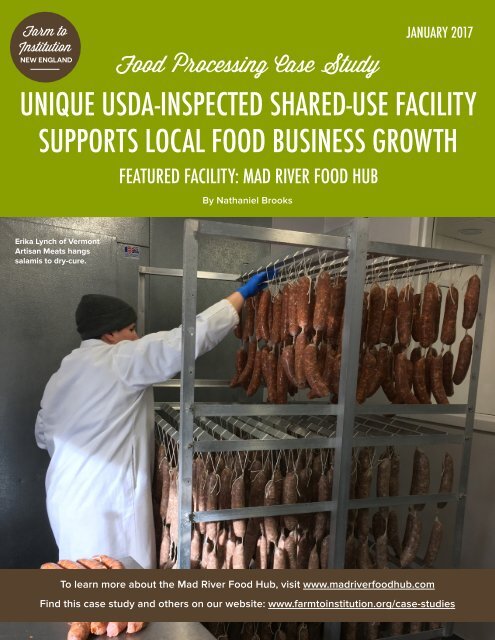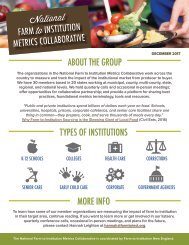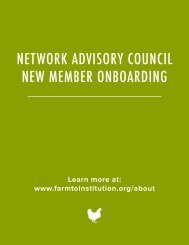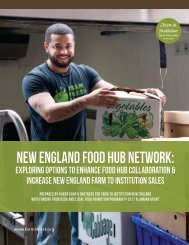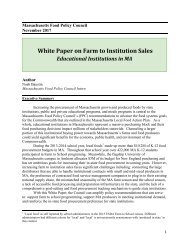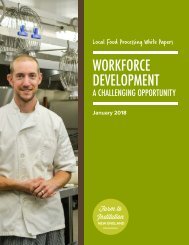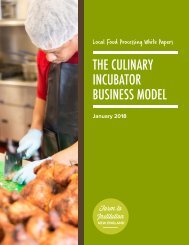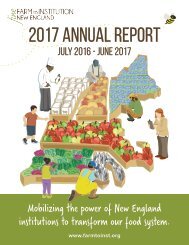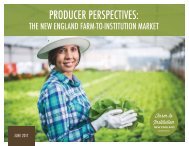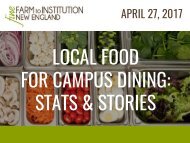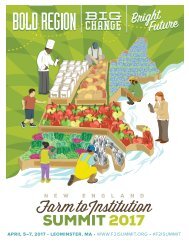Mad River Food Hub Case Study
You also want an ePaper? Increase the reach of your titles
YUMPU automatically turns print PDFs into web optimized ePapers that Google loves.
Farm to<br />
Institution<br />
NEW ENGLAND<br />
<strong>Food</strong> Processing <strong>Case</strong> <strong>Study</strong><br />
JANUARY 2017<br />
UNIQUE USDA-INSPECTED SHARED-USE FACILITY<br />
SUPPORTS LOCAL FOOD BUSINESS GROWTH<br />
FEATURED FACILITY: MAD RIVER FOOD HUB<br />
By Nathaniel Brooks<br />
Erika Lynch of Vermont<br />
Artisan Meats hangs<br />
salamis to dry-cure.<br />
To learn more about the <strong>Mad</strong> <strong>River</strong> <strong>Food</strong> <strong>Hub</strong>, visit www.madriverfoodhub.com<br />
Find this case study and others on our website: www.farmtoinstitution.org/case-studies<br />
FOOD PROCESSORS COMMUNITY OF PRACTICE CASE STUDY | MAD RIVER FOOD HUB PAGE 1
OVERVIEW<br />
Name: <strong>Mad</strong> <strong>River</strong> <strong>Food</strong> <strong>Hub</strong><br />
Location: Waitsfield, VT<br />
Opened: October 2011<br />
Business Model: L3C<br />
Staff: four full-time, one parttime<br />
(founder)<br />
Facility at a Glance:<br />
• 5.5k square feet total<br />
• Three processing rooms including smoker<br />
• Dedicated dry-cured meat facility<br />
• Dry, cold and frozen storage<br />
• Local distribution and backhauling<br />
Annual Revenue/Budget: $300,000<br />
Total Customers to Date: 193 (average of 50 per year)<br />
Services: processing space and storage rental,<br />
technical assistance including HACCP plan<br />
development, business advising, co-processing,<br />
distribution to local (within 50 miles) markets<br />
KEY TAKEAWAYS<br />
1<br />
2<br />
3<br />
4<br />
Community partnerships are<br />
critical to success.<br />
Regulators are a resource, not<br />
adversaries.<br />
Recruiting customers ahead of<br />
time assures the right products<br />
and services are offered and<br />
drives quick adoption.<br />
A phased approach increases<br />
the odds of success.<br />
See page 8 for more detail<br />
More Information:<br />
The <strong>Mad</strong> <strong>River</strong> <strong>Food</strong> <strong>Hub</strong> (MRFH) was created to stimulate economic development, improve farm viability, and<br />
increase local food production in the <strong>Mad</strong> <strong>River</strong> Valley of Vermont. The first shared-use USDA inspected meat<br />
processing facility in New England, the MRFH offers shared processing rooms, storage, and distribution to best<br />
serve the needs of local farmers and food businesses.<br />
The <strong>Mad</strong> <strong>River</strong> <strong>Food</strong> <strong>Hub</strong> is nestled in Vermont’s<br />
beautiful <strong>Mad</strong> <strong>River</strong> Valley. Photo by Silas Hagerty.<br />
FOOD PROCESSORS COMMUNITY OF PRACTICE CASE STUDY | MAD RIVER FOOD HUB PAGE 2
THE CHALLENGE<br />
The creation of the <strong>Mad</strong> <strong>River</strong> <strong>Food</strong> <strong>Hub</strong> (MRFH), the<br />
first USDA-inspected shared use meat processing<br />
facility in New England, is a story of creative<br />
repurposing of existing resources and the forging<br />
of community partnerships to respond to systemic<br />
challenges. Robin Morris, a long-time entrepreneur<br />
and resident of the <strong>Mad</strong> <strong>River</strong> Valley since 1994, had<br />
purchased the Irasville Business Park (previously<br />
the manufacturing facility for <strong>Mad</strong> <strong>River</strong> canoes) in<br />
Waitsfield with partner Vince Gauthier in 2003. When<br />
then-tenant American Flatbread Company moved<br />
their frozen pizza operation to New Hampshire in<br />
2009, Morris, previously CFO of the company, asked<br />
George Schenk (the founder) if he could purchase the<br />
large freezers as they were an important community<br />
resource; he then began offering cold storage at the<br />
business park.<br />
In parallel with these transitions in the business<br />
park, there was growing interest in the community<br />
in what could be done to support local economic<br />
development. The <strong>Mad</strong> <strong>River</strong> Valley Localvores, a<br />
group to which Morris belonged, was particularly<br />
active in the effort to increase appreciation for local<br />
foods and support the long-term viability of local<br />
farms. The well-publicized success of Hardwick,<br />
Vermont in developing a farm and food-based<br />
economy was on many minds, especially as longtime<br />
residents grappled with increasing development<br />
geared towards seasonal tourism. In this fertile<br />
ground, the purchase of the large freezers planted<br />
the seed of an idea: the possibility of transforming the<br />
former canoe-factory into a new type of business, one<br />
with a mission of economic development grounded in<br />
local food businesses… a food hub.<br />
As the business plan for the MRFH was developed,<br />
it became clear that the facility would have the best<br />
chance of long-term success in serving its mission by<br />
addressing three interconnected challenges facing<br />
producers in New England:<br />
1. With a relatively short growing season, producers<br />
were struggling to meet the growing demand<br />
for local products year-round. Value-added<br />
production would offer farms a means to maintain<br />
year-round customer relationships, as well as<br />
capture higher margins for their products.<br />
2. There was a lack of on-farm processing capacity.<br />
A shared-use facility would offer the opportunity<br />
to try value-added production without the capital<br />
expenditures or the ongoing overhead of a<br />
dedicated facility.<br />
3. Options for small meat producers were extremely<br />
limited. As reported in the Vermont Farm to Plate<br />
Strategic Plan, “between 1997 and 2010 the<br />
number of commercial red meat slaughter and<br />
processing plants in Vermont decreased from<br />
14 to 8, and the number of commercial red meat<br />
processing plants decreased from 23 to 14.”1<br />
Creating a USDA-inspected facility accessible to<br />
small producers would relieve this bottleneck,<br />
give producers the consistency and control they<br />
wanted and allow the development of valueadded<br />
meat products.<br />
__________________<br />
1 Vermont Farm to Plate Strategic Plan, 3.4, p 6<br />
A member of the Agricola Farm team prepares to butcher<br />
one of their heritage breed pigs in the MRFH meat<br />
processing room.<br />
FOOD PROCESSORS COMMUNITY OF PRACTICE CASE STUDY | MAD RIVER FOOD HUB PAGE 3
CREATION OF THE MAD RIVER FOOD HUB<br />
In 2010, Morris began the research necessary to put<br />
together a strategic plan for the MRFH. In addition to<br />
secondary research and visiting existing food hubs,<br />
Morris conducted extensive stakeholder surveys<br />
with people who, in his words, “knew food, knew<br />
Vermont, and knew the community.” At the same<br />
time, he was able to leverage the comprehensive<br />
market research that had recently been completed<br />
by the Vermont Sustainable Jobs Fund (VSJF) to<br />
support the development of Vermont’s Farm to<br />
Plate Strategic Plan. This research in particular<br />
demonstrated the bottleneck in existing meat<br />
processing capacity and supported the decision to<br />
offer this service at the MRFH.<br />
The ability to offer meat processing would also help<br />
differentiate the MRFH from the shared-use Vermont<br />
<strong>Food</strong> Venture Center in Hardwick, which was under<br />
development at the same time but had elected not to<br />
pursue USDA inspection. Finally, Morris determined<br />
meat processing would improve the chances of<br />
MAD RIVER FOOD HUB FLOORPLAN<br />
maintaining a high facility utilization, as local meat<br />
is available more of the year than local produce.<br />
Despite the challenge of constructing a facility to<br />
meet the rigorous sanitation standards required, and<br />
the greater risk inherent in handling meat products,<br />
financial projections made it clear that the facility<br />
couldn’t achieve long-term financial sustainability<br />
without the differentiation and season-extension meat<br />
processing would allow.<br />
Facility design and business planning were an<br />
interdependent process, with the requirements of<br />
different services informing design for the space,<br />
which in turn informed cost estimates and financial<br />
projections. Another key part of developing the<br />
vision for the MRFH was the creation of a board of<br />
advisors. This group of knowledgeable individuals<br />
helped Morris refine plans for the facility and<br />
connect with potential clients. The business plan<br />
that eventually emerged from this iterative process<br />
of research, design, and analysis consisted of three<br />
interconnected service offerings:<br />
1. Processing, to allow the creation of value-added<br />
products.<br />
2. Storage, to leverage the existing freezer, cooler,<br />
and dry storage to support users of the processing<br />
space, as well as area producers who needed<br />
storage capacity to expand their own operations.<br />
3. Distribution, to fill a gap in the market between<br />
state/regional distributors and farmers handling<br />
their own deliveries, which was inefficient and<br />
not their preferred use of time. Refrigerated<br />
distribution also gave the MRFH the ability to<br />
support meat producers in moving meat from<br />
slaughterhouse to the facility and meeting food<br />
safety standards.<br />
FOOD PROCESSORS COMMUNITY OF PRACTICE CASE STUDY | MAD RIVER FOOD HUB PAGE 4
These services were offered in a phased approach,<br />
beginning with storage (spring 2011), then<br />
processing under state inspection (October 2011),<br />
smoking and processing under federal inspection<br />
(April 2012), distribution (beginning October 2011,<br />
but really scaled July 2012), and smoking & curing<br />
under USDA inspection which came on line in<br />
2015. This sequence allowed the immediate use of<br />
existing assets and gave the organization time to<br />
learn from each stage of operations before tackling<br />
the complexity of the next.<br />
FACILITY CAPITAL COST<br />
Divided by funding source ($396k total)<br />
Governor Shumlin addresses the crowd at the opening<br />
of the MRFH. Over 200 people attended the opening on<br />
a day with freezing rain in January 2012.<br />
Valley Chamber of Commerce using funds from a<br />
USDA Rural Business Enterprise Grant. The MRFH<br />
insures and maintains the equipment and, through<br />
its role as a business incubator, supports the<br />
Chamber’s mission of growing local businesses.<br />
The capital expenditure needed to set up the<br />
facility to USDA standards was significant. Morris<br />
had chosen to set up the MRFH as a Low-Profit<br />
Limited Liability Company (L3C), a relatively new<br />
corporate form that combines the social mission<br />
of a not-for-profit with the simple and flexible<br />
business structure of a common LLC. Without<br />
being able to tap into grant funding for some of<br />
the equipment and facilities build-out, however,<br />
the organization wouldn’t have been financially<br />
viable. The MRFH was denied the first two grants it<br />
applied for, in part because of the novel corporate<br />
structure. Developing relationships with funders<br />
and clearly articulating the mission of the business,<br />
differentiating this project from other similar projects<br />
in the state, as well as being strategic about which<br />
grants to pursue were important to later success.<br />
The MRFH also found ways to partner with a variety<br />
of community organizations in pursuing grant<br />
funding. The majority of the MRFH equipment, for<br />
example, was actually purchased by the <strong>Mad</strong> <strong>River</strong><br />
Despite the strong base of existing assets, including<br />
the existing high-bay structure with three phase<br />
power, water, loading docks, and many of the<br />
other features critical to a meat processing facility,<br />
a number of uncertainties were encountered<br />
in the planning process. Chief amongst these<br />
was uncertainty about whether the site could be<br />
granted a wastewater permit (required by both state<br />
and USDA regulators). Waitsfield doesn’t have a<br />
municipal system and it was initially unclear if the<br />
business park’s private system had the capacity to<br />
support projected operations. Morris was proactive<br />
in engaging with the Agency of Natural Resources<br />
Department of Environmental Conservation (the<br />
body in charge of granting wastewater permits), a<br />
local engineer was hired to evaluate the existing<br />
system, and the existing system was permitted<br />
before any construction was started. Morris credits<br />
proactively developing relationships with regulators,<br />
treating them as a resource, and maintaining open<br />
communications with ensuring potential problems<br />
such as this were identified early and resolved in a<br />
timely manner. Because of this proactive approach,<br />
once the initial facility build-out was completed, a<br />
three month process, all permits were granted on<br />
first inspection by the relevant regulators.<br />
FOOD PROCESSORS COMMUNITY OF PRACTICE CASE STUDY | MAD RIVER FOOD HUB PAGE 5
As soon as the MRFH opened its doors, the<br />
importance of Morris’ group of advisors and the<br />
work of reaching out to potential customers was<br />
on show. Fourteen potential clients had been softcircled<br />
prior to opening, leading to 40% occupancy<br />
of cold storage, and 30% initial occupancy of<br />
processing rooms. Ten of those fourteen producers<br />
have been or are now regular MRFH clients. Morris<br />
has continued this approach of engaging potential<br />
clients throughout every stage of the MRFH’s<br />
growth. The beginning of the distribution offering,<br />
for example, was undertaken in partnership with<br />
Lawson’s Finest Liquids on a cost sharing basis, and<br />
Lawson’s continues today as the anchor client for<br />
this service. Similarly, the build out of the dry-cured<br />
meat facility wasn’t undertaken until an agreement<br />
was reached with Pete Colman of Vermont Salumi in<br />
July 2012 to serve as an anchor client and provide<br />
input and guidance on facility development. This<br />
partnership-based, demand-led approach has<br />
helped the MRFH minimize risk and ensure it stays<br />
responsive to the market it serves.<br />
Since opening, the MRFH has stayed small and<br />
nimble, pivoting to react to the demands of its<br />
customers while staying true to its mission of<br />
stimulating economic development and supporting<br />
farm viability. As is true of many new enterprises,<br />
the organization has at times struggled to build<br />
the right team to execute on its mission. The first<br />
operations manager, Jacob Finsen, an instrumental<br />
part of the facility design and build-out, provides a<br />
case in point. Finsen had experience as a butcher<br />
and enjoyed the work of cutting meat. Early in<br />
the evolution of the MRFH, he took on a number<br />
of contract-manufacturing projects for local<br />
farms. This led to internal challenges, as Morris<br />
felt strongly that taking on the work, rather than<br />
enabling producers to process their own products,<br />
wasn’t serving the mission of helping develop new<br />
and expanded businesses. Ultimately, a happy<br />
compromise was reached: Finsen left his operations<br />
role at the MRFH and, with his brother, launched his<br />
own custom butchery company, Artisan Meats of<br />
Vermont, which became a client of the MRFH and<br />
has been instrumental in the success of the the drycured<br />
meat facility.<br />
Mulu Tewelde and Alganesh Michael prepare a meal in<br />
the MRFH kitchen for a popup Ethiopian restaurant.<br />
Robert Percy of Artisan Meats of Vermont slices bacon<br />
in the MRFH meat processing room.<br />
FOOD PROCESSORS COMMUNITY OF PRACTICE CASE STUDY | MAD RIVER FOOD HUB PAGE 6
THE MAD RIVER FOOD HUB TODAY<br />
Since bringing the meat curing facility fully online<br />
in 2013, the MRFH team has focused on refining<br />
operations and strengthening organization financials.<br />
With an average of 50 clients using the facility’s<br />
services in some manner every month, the food hub has<br />
taken on a key role in the food system of the <strong>Mad</strong> <strong>River</strong><br />
Valley.<br />
“The MRFH is serving as a leverage point in<br />
the MRV food system. In addition to jobs in<br />
the facility, it is providing support for existing<br />
businesses to expand. The facility makes it<br />
easier for businesses to expand into value added<br />
products, accelerating development and reducing<br />
risk. For instance, existing sugar makers that can<br />
now take their experimentation of candy making<br />
into the next stage due the the minimization of<br />
costs for space and equipment.”<br />
– Joshua Schwartz, Executive Director of the<br />
<strong>Mad</strong> <strong>River</strong> Valley Planning District<br />
Despite the key role it plays in the local food system,<br />
keeping facility utilization high enough to fully support<br />
operations continues to be a struggle for the MRFH.<br />
This challenge is due in part to its success as an<br />
incubator. The 2015 graduation of two highly successful<br />
clients, for example, dropped kitchen utilization from<br />
75% to approximately 40%. Both Joe’s Soups and<br />
VT Bean Crafters had been producing at the facility<br />
for several years, and had successfully grown their<br />
sales to the point where it was more economical for<br />
them to construct their own dedicated production<br />
facilities. In part this success came through targeting<br />
institutional accounts (both count the University of<br />
Vermont among their customers, Vermont Bean<br />
Crafters also sells to a variety of Burlington-area<br />
schools). This challenge, common to business<br />
incubators everywhere, is particularly exacerbated<br />
in the case of the MRFH, with its rural location and<br />
limited population of potential users. Despite these<br />
challenges, Morris is currently talking to four new<br />
businesses looking to get started at the facility, two<br />
of which are focused on cured meat products.<br />
Even though the organization continues to grapple<br />
with the challenge of building a customer pipeline,<br />
Morris is confident stating that the organization<br />
has achieved the goals laid out in its business plan<br />
five years ago. As of fall 2016, he has begun work<br />
on “<strong>Mad</strong> <strong>River</strong> <strong>Food</strong> <strong>Hub</strong> 2.0,” again looking for<br />
the best way to utilize assets to support long-term<br />
organization sustainability and the next phase of<br />
food business growth.<br />
The 2016 class of University of Vermont’s <strong>Food</strong> <strong>Hub</strong> Management Program, which Morris helped create, visits the MRFH.<br />
FOOD PROCESSORS COMMUNITY OF PRACTICE CASE STUDY | MAD RIVER FOOD HUB PAGE 7
KEY TAKEAWAYS<br />
1<br />
2<br />
3<br />
4<br />
Community partnerships are critical to success.<br />
Morris came to the idea for the food hub through involvement in the ongoing community<br />
conversations around economic development and local food. The partnerships<br />
established with different community organizations to apply for various grants were<br />
critical to funding the construction and outfitting of the facility.<br />
Regulators are a resource, not adversaries.<br />
Communicating early and often with both state and federal regulatory agencies<br />
helped identify and resolve potential roadblocks before they could derail the project.<br />
Approached in a spirit of good faith and partnership the regulators were willing to work<br />
with Morris to do something unprecedented.<br />
Recruiting customers ahead of time assures the right<br />
products and services are offered and drives quick<br />
adoption.<br />
Morris and his team of advisors had soft-circled 14 potential users of the MRFH before<br />
beginning the fit-out. Similarly, distribution only started once an anchor client was<br />
identified and the construction of a dry-curing space wasn’t begun until an anchor tenant<br />
was assured. In each case, the effort to engage potential customers helped avoid lost<br />
revenue and underutilized capacity, which would have been challenging to the business.<br />
A phased approach increases the odds of success.<br />
By separating out different services, and sequencing their launch in increasing order of<br />
difficulty the MRFH staff gave themselves time to learn from each stage of the project,<br />
increasing their chances of success for the next. The phased approach had two other<br />
critical advantages: first, it allowed the facility to quickly monetize existing assets<br />
(freezers) even while building out other services. Second, it sidestepped the possibility of<br />
delays on one front (e.g., USDA grant of inspection) preventing other uses.<br />
Find this case study and others on our website: www.farmtoinstitution.org/case-studies<br />
Learn more about Farm to Institution New England at www.farmtoinstitution.org<br />
FOOD PROCESSORS COMMUNITY OF PRACTICE CASE STUDY | MAD RIVER FOOD HUB PAGE 8


